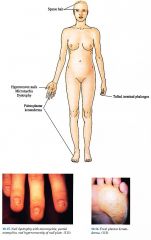![]()
![]()
![]()
Use LEFT and RIGHT arrow keys to navigate between flashcards;
Use UP and DOWN arrow keys to flip the card;
H to show hint;
A reads text to speech;
11 Cards in this Set
- Front
- Back
|
Clinical Hidrotic Ectodermal Dysplasia/ Clouston Syndrome
|

|
|
|
Synonym
|
Clouston syndrome
|
|
|
Inheritance
Prenatal |
Autosomal dominant; connexin 30 (GJB6) gene on 13q11 12
None listed |
|
|
Incidence
|
Rare; most common in French Canadian and French population; M=F
|
|
|
Age at Presentation
|
Birth to neonatal period
|
|
|
Pathogenesis
|
Mutation in connexin 30 leads to defective ectodermal development and maintenance
|
|
|
Clinical
|
Skin
Palmoplantar keratoderma with transgradiens Nails Dystrophy thickened, milky white early on, micronychia, hyperconvex, longitudinal striations, discolored, brittle, absent Paronychial infections with/without nail matrix destruction Hair Scalp normal early on but often becomes thin, wiry, brittle, pale, sparse, or absent after puberty Body, eyelashes, eyebrows sparse to absent; secondary conjunctivitis, blepharitis Musculoskeletal Tufting of terminal phalanges and thickened skull bones may occur |
|
|
D/Dx
|
Other PPK’s
Pachyonychia congenita |
|
|
Lab
|
None Listed
|
|
|
Management
|
Referral to dermatologist diagnosis, keratolytics, surgical debridement, antibiotics (paronychia), wigs and nail sculpturing /bonding for cosmesis; nail matrix ablation to relieve pain
|
|
|
Prognosis
|
Normal life span
|

